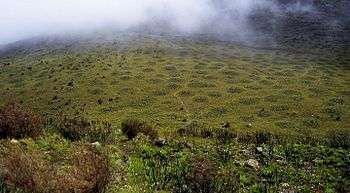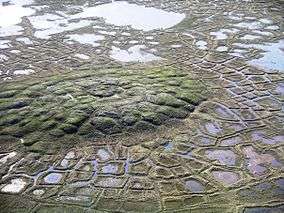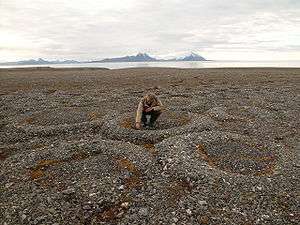Patterned ground
Patterned ground is the distinct and often symmetrical natural pattern of geometric shapes formed by ground material in periglacial regions. It is typically found in remote regions of the Arctic, Antarctica, and the Outback in Australia, but is also found anywhere that freezing and thawing of soil alternate; patterned ground has also been observed on Mars.[2] The geometric shapes and patterns associated with patterned ground are often mistaken as artistic human creations. The mechanism of the formation of patterned ground had long puzzled scientists but the introduction of computer-generated geological models in the past 20 years has allowed scientists to relate it to frost heaving, the expansion that occurs when wet, fine-grained, and porous soils freeze.


Types
Patterned ground can be found in a variety of forms. Typically, the type of patterned ground in a given area is related to the prevalence of larger stones in local soils and the frequency of freeze-thaw cycles.[3][4][5][6][7][8]
Polygons

Polygons can form either in permafrost areas (as ice wedges) or in areas that are affected by seasonal frost. The rocks that make up these raised stone rings typically decrease in size with depth.[5]
In the northern reaches of the Canadian Boreal forests, when bogs reach a eutrophic climax and create a sedge mat, Tamarack Larch and Black Spruce are often the early colonists within such a polygonal climax sedge mat.[9]
Circles

Circles range in size from a few centimeters to several meters in diameter. Circles can consist of both sorted and unsorted material, and generally occur with fine sediments in the center surrounded by a circle of larger stones. Unsorted circles are similar, but rather than being surrounded by a circle of larger stones, they are bounded by a circular margin of vegetation.[10][5]
Steps
Steps can be developed from circles and polygons. This form of patterned ground is generally a terrace-like feature that has a border of either larger stones or vegetation on the downslope side, and can consist of either sorted or unsorted material.[3][5]
Stripes
Stripes are lines of stones, vegetation, and/or soil that typically form from transitioning steps on slopes at angles between 2° and 7°. Stripes can consist of either sorted or unsorted material. Sorted stripes are lines of larger stones separated by areas of smaller stones, fine sediment, or vegetation. Unsorted stripes typically consist of lines of vegetation or soil that are separated by bare ground.[11][12][5]
Formation

In periglacial areas and areas affected by seasonal frost, repeated freezing and thawing of groundwater forces larger stones toward the surface, as smaller stones flow and settle underneath larger stones. At the surface, areas that are rich in larger stones contain much less water than highly porous areas of finer grained sediments. These water-saturated areas of finer sediments have a much greater ability to expand and contract as freezing and thawing occur, leading to lateral forces which ultimately pile larger stones into clusters and stripes. Through time, repeated freeze-thaw cycles smooth out irregularities and odd-shaped piles to form the common polygons, circles, and stripes of patterned ground.[13]
Patterned ground occurs in alpine areas with freeze thaw cycles. For example, on Mount Kenya seasonal frost layer is a few centimetres (inches) below the surface in places.[1] Patterned ground is present at 3,400 metres (11,155 ft) to the west of Mugi Hill.[14] These mounds grow because of the repeated freezing and thawing of the ground drawing in more water. There are blockfields present around 4,000 metres (13,123 ft) where the ground has cracked to form hexagons. Solifluction occurs when the night temperatures freeze the soil before it thaws again in the morning. This daily expansion and contraction of the soil prevents the establishment of vegetation.[15]
Frost also sorts the sediments in the ground. Once the mantle has been weathered, finer particles tend to migrate away from the freezing front, and larger particles migrate through the action of gravity. Patterned ground forms mostly within the active layer of permafrost.[13][16]
References
- Grab, Stefan W.; Gatebe, Charles K.; Kinyua, Antony M. (2004). "Ground Thermal Profiles from Mount Kenya, East Africa". Geografiska Annaler. Series A, Physical Geography. 86 (2): 131–141. doi:10.1111/j.0435-3676.2004.00219.x. ISSN 0435-3676. JSTOR 3566103.
- "Southern Hemisphere Polygonal Patterned Ground". Mars Global Surveyor: Mars Orbiter Camera. Malin Space Science Systems. Archived from the original on 27 October 2016. Retrieved 8 November 2013.
- "Patterned Ground". Retrieved 21 September 2016.
- Ballantyne, C.K. (1986). "Non-sorted patterned ground on mountains in the Northern Highlands of Scotland". Biuletyn Peryglacjalny. 30: 15–34.
- Allaby, Michael (2013). A Dictionary of Geology and Earth Sciences. Oxford University Press. p. 429. ISBN 978-0-19-107895-8.
- Ólafur, Ingólfsson (2006). "Glacial Geology Photos". Retrieved March 4, 2007.
- Kessler M.A.; Werner B.T. (January 2003). "Self-organization of sorted patterned ground". Science. 299 (5605): 380–3. doi:10.1126/science.1077309. PMID 12532013.
- Marchant, D.R.; Lewis, A.R.; Phillips, W.M.; Moore, E.J.; Souchez, R.A.; Denton, G.H.; Sugden, D.E.; Potter Jr., N.; Landis, G.P. (2002). "Formation of Patterned Ground and Sublimation Till over Miocene Glacier Ice in Beacon Valley, Southern Victoria Land, Antarctica". Geological Society of America Bulletin. 114 (6): 718–730. doi:10.1130/0016-7606(2002)114<0718:fopgas>2.0.co;2.
- C. Michael Hogan. 2008. Black Spruce: Picea mariana, GlobalTwitcher.com, ed. N. Stromberg Archived 2011-10-05 at the Wayback Machine
- Hallet, Bernard (2013). "Stone circles: form and soil kinematics". Phil. Trans. R. Soc. Lond. A. 371 (2004): 20120357. doi:10.1098/rsta.2012.0357. PMID 24191111.
- King, R. B. (1971). "Boulder polygons and stripes in the Cairngorm Mountains, Scotland". Journal of Glaciology. 10 (60): 375–386. doi:10.1017/s0022143000022073.
- Ballantyne, Colin K. (2001). "The sorted stone stripes of Tingo Hill". Scottish Geographical Journal. 117 (4): 313–324. doi:10.1080/00369220118737131.
- Easterbrook, Don J. (1999). Surface processes and landforms (2nd ed.). Prentice Hall. pp. 418–422. ISBN 978-0-13-860958-0.
- Baker, B. H. (1967). Geology of the Mount Kenya area; degree sheet 44 N.W. quarter (with coloured map). Nairobi: Geological Survey of Kenya.
- Allan, Iain (1981). The Mountain Club of Kenya Guide to Mount Kenya and Kilimanjaro. Nairobi: Mountain Club of Kenya. ISBN 978-9966985606.
- Perkins, S. (17 May 2003). "Patterns from Nowhere; Natural Forces Bring Order to Untouched Ground". Science News. 163 (20): 314–316. doi:10.2307/4014632. JSTOR 4014632.
External links
